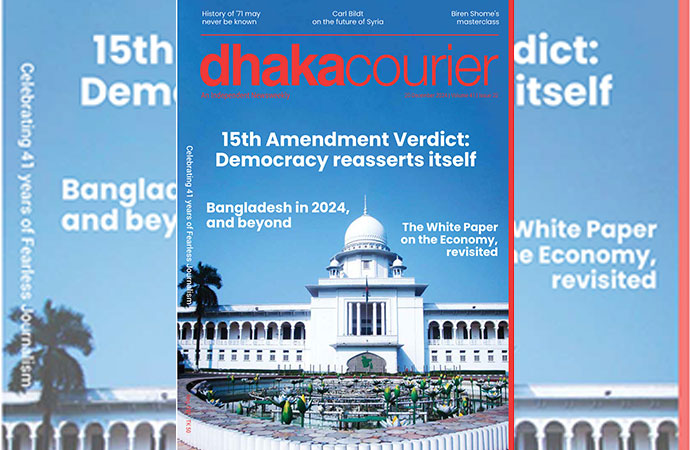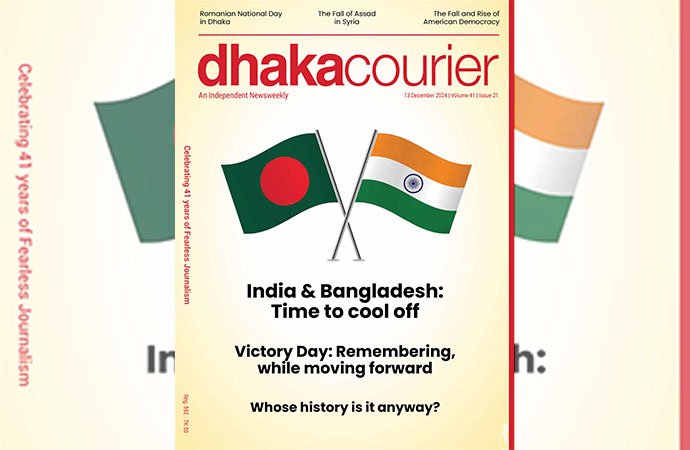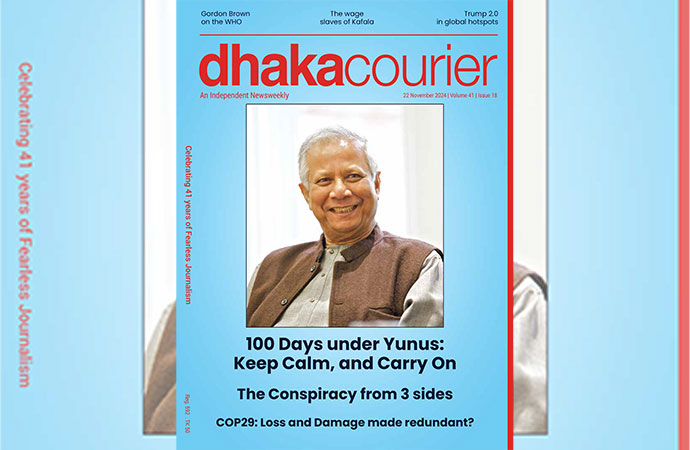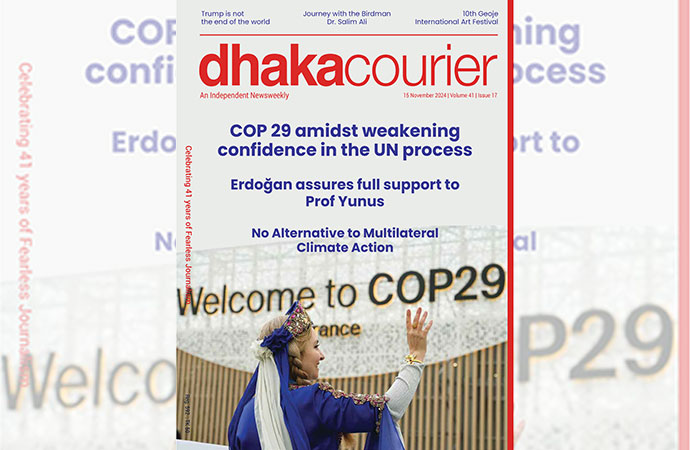Society

On being invited jointly by the Chinese Academy of Social Sciences and the National Institute for Global Strategy, I flew to Beijing to attend the 15 May 2019 International Conference on Dialogue of Asian Civilizations. The conference was a huge one that had six parallel sessions of which 'Mutual learning among Asian civilizations and building a global community with a shared future for mankind' was what I took part in. As a matter of fact, I was invited to give a paper and I chose to write to reflect my views on Asian civilizations setting them in context of the world in the 21st century. The opening ceremony was held in Beijing National Convention Centre where the Chinese President Xi Jinping addressed as the Chief Guest. Among others were present Cambodian King Norodom Sihamoni , Greek President Prokopios Pavlopoulos, Singaporean President Halimah binti Yacob, Sri Lankan President Maithripala Sirisena, Armenian Prime Minister Nikol Pashinyan and UNESCO Director-General Audrey Azoulay. Delegates from 47 countries of 5 continents participated in the conference. On request of the conference organizers I wrote a fairly long paper to share my thoughts about such an issue of the first magnitude with a larger circle of people. I was also invited to speak in brief in a discussion session about what I wrote on Asian civilizations. My piece has been organized into some chapters which will marshal my views on how a proper understanding of Asian civilizations can help build a regional and thereby a global community with a shared destiny for mankind. The following is a full account of the paper I wrote for Beijing conference.
The daunting prospect of a global community:
'East is East, and West is West, and never the twain shall meet'- sighed the Indian-born English poet and novelist Rudyard Kipling in his poem 'The Ballad of East and West'. While the British imperialism's literary spokesman, Mr. Kipling saw no possibility of integration of the East and the West, the Republic of China heralds a new era of global community with a shared destiny for mankind. As the former Chinese Communist Party General Secretary Hu Jintao puts it in a report in 2012, "Mankind has only one earth to live on, and countries have only one world to share." The current Chinese President and the country's paramount leader Xi Jinping, too, makes us hope against hope by saying that the global community is increasingly becoming a community of shared future. In his 15 May 2019 Beijing speech, the Chinese leader reiterates his calls for a global community with a shared destiny and urges caution that in the face of overwhelming global problems, no country could stay safe by itself alone. And hence, China is looking for ways of building closer cooperation between the East and the West by promoting mutual learning among the Asian peoples and civilizations. Asia's first Nobel laureate and the Bengali literary giant Rabindranath Tagore (1861-1941) was also very optimistic about the prospect of regional and global integration. One of the 60 most influential foreigners who contributed to the building of modern China, Tagore appreciated the traditional, friendly and interactive relationship and cultural exchanges between India and China. So, the prospect of a greater connectivity, mutual understanding and deeper integration among the people of Asia and the world is a daunting prospect.
China's vision of globalization:
A country like China whose avowed vision, as expressed by President Xi, is to create an atmosphere of global mutual understanding and learning, pursuit of common interest, and expansion of openness, is game for taking the lead in building a global community of shared future for mankind. By promoting closer people to people contact, fostering better relations with the countries of the region, exchanging cultures and sharing common responsibilities, China can play its role as the catalyst for this integration. The country is no longer what Napoleon Bonaparte, the first emperor of France and one of the greatest military leaders in the west once dubbed it-- 'a sleeping giant'. The shrewd general perhaps could very well apprehend China's potential to grow as a country to lead the world and hence forbade people from waking her up, maybe, due to, sort of, raciest jealousy. However, Napoleon's advice did not work and China has been wide awake and going into the lead in different areas of achievements across the world.
Civilizations of Asia:
Asia, the largest and the most populous continent in the world, is a melting pot of civilizations and cultures. Many great and ancient civilizations have sprung from five regions of Asia - West Asia, East Asia, South Asia, Central Asia and Southeast Asia. Out of the four early river valley civilizations, three were Asian, i.e. Mesopotamian civilization based on the Tigris and Euphrates rivers, Indian civilization on the Indus River and Ancient Chinese civilization on the Huang He (Yellow) river. The Mesopotamian civilization that grew up in the river valley of Tigris and Euphrates 5000 years BC included the Sumerian, the Babylonian and the Assyrian civilizations. They established cities and developed administration, art, architecture, literature, trade and commerce. Indus Valley civilization was another ancient Asian civilization which shows the first signs of urbanization. The evidence supports the fact that the ancient Indus Valley community had a highly developed city life facilitated by houses with wells and bathrooms and elaborate underground drainage system. Over the ages, these civilizations of Asia have greatly influenced the people of this region and exerted a strong influence on others as well. Looking back on the past of Asia may help better understand the present of the Asians and the people of the world. As Winston Churchill puts it, "The farther backward you can look, the farther forward you are likely to see." A perfect knowledge of Asian civilizations may help the agents for socio-cultural changes to contribute to the building of a world community with a shared future for mankind.
Chinese civilization and its impact:
Though China's early ancient history is shrouded in uncertainty, most historians are of the opinion that China was the cradle of one of the four early civilizations (Indian, Mesopotamian, Egyptian and Chinese) discovered around the world. The key characteristic of Chinese civilization is that it is the oldest continuous civilization in the world. While the other three civilizations gradually disappeared, the Chinese civilization continued to exist. The culture that originated and developed in Ancient China assumed the form of the present day Chinese nation. Though there have been changes along the way of evolution, a fairly homogeneous culture has evolved in China. In addition, Chinese civilization had exerted a tremendous influence on East Asia especially on Korea and Japan. Prior to the Mongol conquest during the Sui, Tang and Song dynasties, many innovations like paper money and tea cultivation occurred.
The Silk Road and the integration of civilizations:
The Silk Road, the ancient transcontinental network of terrestrial trade routes connecting East Asia and Southeast Asia with East Africa and Southern Europe, passed through the four great civilizations, i. e. the Mesopotamian, the Indus Valley, the Chinese and the Egyptian. It became the confluence of the major religions in the world-- Christianity, Buddhism and Islam and various ethnic cultures existed together in peace and harmony along the road. The valleys of the rivers--the Nile, the Tigris and Euphrates, the Indus, the Ganges, the Yangtz and the Yellow are all cradles of civilization. And all the creeds, ideas and dogmas, all cultures and values belonging to both the East and the West are deeply rooted in civilizations and religions developed along the Silk Road. Mutual learning among these civilizations may sure contribute to the building up of a global community with a shared destiny. And various other factors like geography, climate, history, economy, and lifestyles also contribute to the diversity of global cultures which may enrich civilizations and make them "become more colourful through exchange and mutual learning," (Chinese President Xi Jinping in a 2014 speech at UNESCO Headquarters). "Such exchange and mutual learning serve as important drivers of human progress and global peace and development," the paramount leader added. UNESCO gives special attention to exchange of cultures between China and the West. Exchange and mutual learning among civilizations promotes openness and inclusiveness. The Silk Road tells the story of different civilizations evolving together with closer integration, of different cultures and religions developing together with inclusiveness and dialogue, and of peoples enjoying mutual prosperity via myriad communications and exchanges.
China's regional academic cooperation initiative:
The establishment of China-South and Southeast Asian University Consortium can also be considered as another aspect of mutual learning among Asian countries aiming at a global community with a shared future. It is a mutual higher education reform endeavour of the region by way of strengthening closer cooperation, people-to people exchanges and above all creating a bright future for education and research. The aims and objectives of the Consortium drawn from the December 2018 Kunming Conference are to create a congenial academic environment for higher education and research in South and Southeast Asia by promoting talents for collaborative and needs-based research and sharing common interests like ICT, life sciences, environmental sciences and ethnic studies among the 'Belt and Road' members. I believe that the establishment of such University Networks under the guidance of Chinese Universities may also bring about remarkable changes in the academia of the region. I am very happy that I have had the chance to attend both the Kunming conferences (2017 and 2018) on that regional academic collaboration building venture and to work in support of the forum.
Misrepresentation of the East by the West:
The deliberate misrepresentation of the East by the West is a big threat to the proper understanding of Asian civilizations. This has been a phenomenon that the long process of colonization was constantly accompanied with. However, in the wake of the process of decolonization in the post-colonial era, new voices of dissent are being raised in the East in favour of so far misrepresented/misunderstood civilizations. Europe's or the West's project of representing/ interpreting the East has been described by Edward W. Said in his 1978 book Orientalism as "the exaggeration of difference, the presumption of Western superiority, and the application of clichéd analytical models for perceiving the Oriental world" (Orientalism (1978). As a public intellectual, Said in his eye-opening book shows how the West's patronizing representations of 'The East'-the societies and peoples who inhabit the places of Asia, North Africa, and the Middle East have been deliberately and unduly construed. The example of Marco Polo (1254-1324), the great Italian traveller, explorer and writer can very well substantiate this act of misrepresentation. Polo travelled around medieval China and many other Asian cities for about 17 years and upon return to Europe, wrote a book called The Travels of Marco Polo (1298).Though he was not the first European to explore China, he was the first who introduced China and Asia to the world through his travelogue. His meticulous travel records included the great size of China, its capital Peking, but quite mysteriously, the Great Wall, which is recognized as one of the most spectacular architectural feats in human history and is often claimed as the only human-made object on this planet visible from space, had escaped the great explorer's notice. On the contrary, what Marco Polo did to China, the Great Chinese pilgrim-traveller Hsuan Tsang did not do to India. Tsang was also a great traveller, scholar and translator and visited India, the birthplace of Buddha, through the Silk Route between AD 627 and 643 in search of true explanations of some contradictions he found in the texts on Buddhism. He, too, spent 17 years of his life travelling around India and his travel details were recorded as the Great Tang Records on the Western Regions. His work on India is very significant and is still helping historians to resolve debates about the then Indian civilization. Tsang visited Pundravandhana, one of the territorial divisions of ancient Bengal (now Bangladesh) and found the country 'rich in all kinds of grain-produce' and discovered that the people were agreeable and prone to learning.
This is how, we see a marked difference in the attitudes of the European and the Asian minds towards the portrayal of others. The representation of the East or Asia or the Orient by the Occident has always tended towards exaggeration which remains a big threat to the proper evaluation of the Asian civilizations. This is sort of an 'Epistemic violence', which is "exerted against or through knowledge,[and] is probably one of the key elements in any process of domination."(Enrique Galván-Álvarez 2010). "The clearest available example of such epistemic violence", says Gayatri Chakravorty Spivak, "is the remotely orchestrated, far-flung, and heterogeneous project to constitute the colonial subject as Other." Mutual learning among Asian civilizations will help rid the East of the plight of otherness.
Religious militancy as a threat to civilization:
As far as the civilizations of Asia are concerned, we see the tragic destruction of antiquities by militants in Afghanistan, Syria, Iraq, and elsewhere that warns against the loss of civilizations and reminds of the importance of preserving them. The damage done by so-called Islamic State militants to the remains of Mesopotamian Civilization in ancient Iraq which is noted for many global firsts - the first writing, the first city, the first written law code, and the first empire, is irreparable .The destruction done to the 3300 years old city of Nimrud is just impossible to imagine. The Taliban destroyed the two world largest Buddha statues in Bamiyan, Afghanistan constructed fourteen centuries ago, in September of 2001 by order of the militant Taliban ruler Mullah Muhammed Omar.
Developing awareness for the preservation of civilization:
A prerequisite for preserving the glories of civilizations /antiquities/artefacts/ archaeological sites is to know about them, to familiarize people with them and to develop an interest in them and a sense of responsibility for their preservation. Lack of proper study of civilizations, the attitude of indifference to their preservation and inadequate tourist attention are also the threats to our cultural history. If local people are made aware of preserving the archaeological sites and develop a sense of history and civilization, they can contribute to the preservation of sites and help resist their destruction quite independently.
Building a global community through mutual understanding:
Increasing religious intolerance, the majority-minority complex and all forms of reactive co- radicalization leading to militancy and fanaticism have become a constant threat to global peace and are hindering the process of building a global community with a shared destiny. We must address ourselves to this crisis in right earnest to build a global human society of racial integration. The world is a melting pot of colour, race and religion. The raiding religious fanatics should not forget that they may be in the majority in their own country, but their equals in another country are in the minority. What they would do to their minority may have an equal and opposite reaction, and prompt their opposite numbers in another country to come up with a tit-for-tat behaviour. Living in the glasshouse, one should not throw stones at others. Therefore, mutual tolerance and peaceful coexistence should be the foremost survival policy of the religious and ethnic communities. To exist is to coexist! One does not need to be crusader for the protection of their race or religion or culture. There is no room for militancy in the civilized world.
Global community and the 4IR (Fourth Industrialization Revolution):
In the new millennium, with the advent of a new era, mankind is on the brink of a new revolution called the Fourth Industrial Revolution (4IR). It has become a global agenda and we must know what it really means and how we should respond to it individually, socially, nationally, regionally and globally. The first Industrial Revolution used steam, the second electricity to mechanize production and the third used electronics and information technology to automate the manufacturing processes. Now the Fourth Industrial Revolution is emerging from the 3rd in the wake of the digital revolution over the last few decades. It could be a fusion of technologies that combines the physical, digital and biological spheres. Compared with the previous ones, the Fourth Industrial Revolution is developing in geometric progression affecting almost every aspect of human life. We have reached such a crossroads that may completely change the way we live, we work and we connect with each other. The fastest growing connectivity with unprecedented processing power, enormous storage capacity, unlimited access to information and emerging technology breakthroughs in fields of Artificial Intelligence (AI), Robotics, the Internet of Things (IoT), Autonomous Vehicles, 3-D Printing, Nanotechnology, and Quantum Computing are real mind-blowing experiences. We have yet to fully understand how we will deal with such a transformation humankind has never ever experienced before. However, one thing is for sure, the response to the Fourth Industrial Revolution must be very comprehensive and we need to develop a coordinated approach to it at home and abroad. The International Forum on 'Mutual Learning among Asian civilization and building a community with a shared future for mankind can very well be a global platform for it.
Conclusion: Viability of the global community
While "world politics is entering a new phase, and intellectuals have not hesitated to proliferate visions of what it will be-the end of history, the return of traditional rivalries between nation states, and the decline of the nation state from the conflicting pulls of tribalism and globalism," (Huntington 1996), China is making solid efforts to boost cultural communications with people across the globe. The American political scientist Samuel P. Huntington in his 1996 book The Clash of Civilizations and the Remaking of World Order hypothesizes that "the fundamental source of conflict in this new world will not be primarily ideological or primarily economic. The great divisions among humankind and the dominating source of conflict will be cultural...the principal conflicts of global politics will occur between nations and groups of different civilizations. The clash of civilizations will dominate global politics. The fault lines between civilizations will be the battle lines of the future."
Huntington's apprehension cannot be glossed over when we see the harrowing incidents of 9/11, the rise of Al-Qaeda, ISIL and the reactive co-radicalization called Islamophobia, the latest manifestation of which happened in Christchurch, New Zealand in the name of 'White Supremacy'. The Chinese endeavour to build a global community with a shared destiny will act as a resistance to what Huntington is apprehensive of- clashes of civilizations caused by all kinds of extremism and all forms of reactive co-radicalization prompted by the abnormal psychology of group dynamics and killing spree. Despite all setbacks in the process of global peace, it is not all doom and gloom for mankind if they can build a community with a shared future.
Writer's bio: Dr. Rashid Askari is a bilingual writer, fictionist, columnist, media personality and the current vice chancellor of Islamic University, Bangladesh. He emerged as a writer in the mid-1990s and by now wrote 7 books and lots of articles/essays which were published at home and abroad. His two Bengali books: Indo-English Literature and Others (Dhaka-1996) and Postmodern Literary and Critical Theory (Dhaka-2002) and two English books: The Wounded Land (Dhaka 2010) and the edited book English Writings of Tagore (3 vols) Dhaka 2012, deserve special mention. His short fiction collection Nineteen Seventy One (New Delhi-- 2018) has been translated into Hindi and French.

























Leave a Comment
Recent Posts
Curtain rises on 6th National ...
The month-long '6th National Sculpture Exhibition 2024', organ ...
Thailand's sea nomads strive t ...
When Hook was a child, he started his days by jumping off the boat tha ...
Liliums grown in Bagerhat show surprising promise fo ..
Bangladesh’s three divisions brace for rain
Prioritise reconstruction of Gaza, West Bank, Lebano ..
In support of the vision set forth by the CA